Sony PCV-RX480DS, PCV-RX463DS, PCV-RX462DS, VAIO PCV-RX490TV, PCV-RX470DS User Manual
...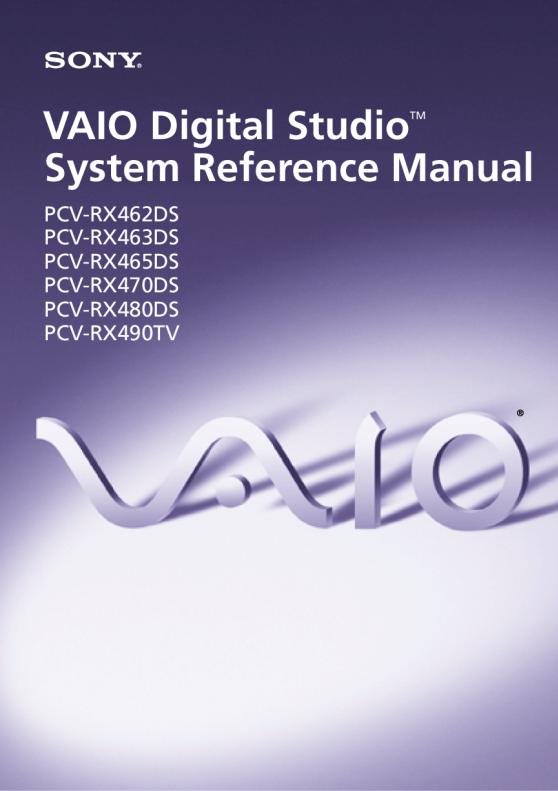
Notice to Users
© 2001 Sony Electronics Inc. Reproduction in whole or in part without written permission is prohibited. All rights reserved. This manual and the software described herein, in whole or in part, may not be reproduced, translated, or reduced to any machine-readable form without prior written approval.
SONY ELECTRONICS INC. PROVIDES NO WARRANTY WITH REGARD TO THIS MANUAL, THE SOFTWARE, OR OTHER INFORMATION CONTAINED HEREIN AND HEREBY EXPRESSLY DISCLAIMS ANY IMPLIED WARRANTIES OF MERCHANTABILITY OR FITNESS FOR ANY PARTICULAR PURPOSE WITH REGARD TO THIS MANUAL, THE SOFTWARE, OR SUCH OTHER INFORMATION. IN NO EVENT SHALL SONY ELECTRONICS INC. BE LIABLE FOR ANY INCIDENTAL, CONSEQUENTIAL, OR SPECIAL DAMAGES, WHETHER BASED ON TORT, CONTRACT, OR OTHERWISE, ARISING OUT OF OR IN CONNECTION WITH THIS MANUAL, THE SOFTWARE, OR OTHER INFORMATION CONTAINED HEREIN OR THE USE THEREOF.
Sony Electronics Inc. reserves the right to make any modification to this manual or the information contained herein at any time without notice. The software described herein is governed by the terms of a separate user license agreement.
This product contains software owned by Sony and licensed by third parties. Use of such software is subject to the terms and conditions of license agreements enclosed with this product. Some of the software may not be transported or used outside the United States. Software specifications are subject to change without notice and may not necessarily be identical to current retail versions.
Updates and additions to software may require an additional charge. Subscriptions to online service providers may require a fee and credit card information. Financial services may require prior arrangements with participating financial institutions.
Sony, VAIO, the VAIO logo, VAIO Digital Studio, and i.LINK are trademarks of Sony. Intel, and Pentium are trademarks of Intel Corporation. Microsoft, Windows, and the Windows Me logo are registered trademarks of Microsoft Corporation. PS/2 is a registered trademark of IBM Corporation. RIMM is a trademark of Rambus Incorporated.
All other trademarks are trademarks or registered trademarks of their respective owners.
Owner’s Record
The model number and serial number are located on the back of your VAIO® computer. Record the serial number in the space provided here. Refer to the model and serial number when you call your Sony Service Center.
Model Numbers: PCV-RX462DS/ PCV-RX463DS/PCV-RX465DS/ PCV-RX470DS/PCV-RX480DS/ PCV-RX490TV
Serial Number:________________________
ii
Safety Information and
Caution
DVD-ROM Laser Diode Properties (PCV-RX462DS/PCV-RX463DS/ PCV-RX465DS/PCV-RX470DS/ PCV-RX480DS)
Laser output |
0.4 mW (DVD) |
|
0.14 mW (CD) |
Wave Length |
650-655 nm (DVD) |
|
785 nm (CD) |
|
|
CD-RW Laser Diode Properties (PCV-RX462DS/PCV-RX463DS/ PCV-RX465DS/PCV-RX470DS/ PCV-RX480DS)
Laser output |
1.0 mW (Read) |
|
|
43.5 mW (Write) |
|
Wave Length |
780–787 nm |
|
|
|
|
DVD-RW Laser Diode Properties |
|
|
(PCV-RX490TV) |
|
|
|
|
|
Laser output |
1.3 mW (CD-read) |
|
|
1.1 mW (DVD-read) |
|
|
21.9 mW (DVD-write) |
|
|
42.8 mW (CD-write) |
|
Wave Length |
650-660 nm (DVD) |
|
|
773-797 nm (CD) |
|
|
|
|
CD-ROM Laser Diode Properties |
|
|
(PCV-RX490TV) |
|
|
|
|
|
Laser output |
0.2 mW |
|
Wave Length |
760-810 nm |
|
|
|
|
To prevent fire or shock hazard, do not expose your desktop to rain or moisture.To avoid electrical shock, do not open the cabinet. Refer servicing to qualified personnel only.
Never install modem or telephone wiring during a lightning storm.
Never install telephone jacks in wet locations unless the jack is specifically designed for wet locations.
Never touch uninsulated telephone wire or terminals unless the telephone line has been disconnected at the network interface.
Use caution when installing or modifying telephone lines.
Avoid using the modem during an electrical storm.
Do not use the modem or a telephone to report a gas leak in the vicinity of the leak.
The socket outlet shall be installed near the equipment and shall be easily accessible.
iii

!To change the backup battery, contact your nearest Sony Service Center.
!Caution - The use of optical instruments with this product will increase eye hazard. As the laser beam used in this product is harmful to the eyes, do not attempt to disassemble the drive cabinet. Refer servicing to qualified personnel only.
!Danger - Visible and invisible laser radiation when drive is open. Avoid direct exposure to beam.
!For CD-RW: Danger - Invisible laser radiation when open. Avoid direct exposure to beam.
!For DVD-RW: Danger - Invisible laser radiation when open. Avoid direct exposure to beam.
!Caution - For ADSL, HomePNA, and V.90 modem models: to reduce the risk of fire, use only No. 26 AWG or larger telecommunication line cord.
Pour prévenir tout risque d’incendie ou d’électrocution, garder cet appareil
àl’abri de la pluie et de l’humidité.
Pour prévenir tout risque d’électrocution, ne pas ouvrir le châssis de cet appareil et ne confier son entretien qu’à une personne qualifiée.
Ne jamais effectuer l’installation de fil modem ou téléphone durant un orage électrique.
Ne jamais effectuer l’installation d’une prise téléphonique dans un endroit mouillé à moins que la prise soit conçue à cet effet.
Ne jamais toucher un fil téléphonique
àdécouvert ou un terminal à moins que la ligne téléphonique n’ait été débranché de l’interface réseau.
Soyez très prudent lorsque vous installez ou modifiez les lignes téléphoniques.
Évitez d’utiliser le modem durant un orage électrique.
N'utilisez pas le modem ni le téléphone pour prévenir d'une fuite de gaz vous êtes près de la fuite.
L’appareil doit être le plus près possible d’une prise murale pour en faciliter l’accès.
iv

!Pour changer la pile de rechange, veuillez contacter votre centre de service Sony le plus près.
!Avertissement : L'utilisation d'instruments optiques avec ce produit augmente les risques pour les yeux. Puisque le faisceau laser utilisé dans ce produit est dommageable pour les yeux, ne tentez pas de désassembler le boîtier. Adressez-vous à un agent de service qualifié.
!Danger : Radiation laser visible et invisible si ouvert. Évitez l’exposition directe au faisceau.
!Pour les CD-RW : Danger : Radiation laser visible et invisible si ouvert. Évitez l'exposition directe au faisceau.
!Pour les DVD-RW : Danger : Radiation laser visible et invisible si ouvert. Évitez l'exposition directe au faisceau.
!Attention : Pour ADSL, HomePNA, et V.90 modele modem : afin de réduire les risques d'incendie, n'utilisez qu'un cordon de communication N0. 26 AWG ou plus gros.
For questions regarding your product or for the Sony Service Center nearest you, call 1-888-476-6972 in the United States or 1-800-961-7669 in Canada.
Sony Customer Support can be reached at http://www.sony.com/pcsupport.
Regulatory Information
Declaration of Conformity
Trade Name: |
SONY |
Model No.: |
PCV-RX462DS |
|
PCV-RX463DS |
|
PCV-RX465DS |
|
PCV-RX470DS |
|
PCV-RX480DS |
|
PCV-RX490TV |
Responsible Party: |
Sony Electronics Inc. |
Address: |
680 Kinderkamack Rd |
|
Oradell, NJ 07649 |
Telephone: |
201-930-6972 |
This phone number is for FCC-related matters only.
This device complies with Part 15 of FCC Rules. Operation is subject to the two following conditions:
(1)This device may not cause harmful interference, and
(2)this device must accept any interference received, including interference that may cause undesired operation.
Model No.: PCVA-IMB4A
This device complies with Part 15 of the FCC rules. Operation is subject to the following two conditions:
(1)This device may not cause harmful interference, and
(2)this device must accept any interference received, including interference that may cause undesired operation.
This equipment has been tested and found to comply with the limits for a Class B digital device, pursuant to Part 15 of the Rules. These limits are designed to provide reasonable protection against harmful interference in a residential installation. This equipment generates, uses, and can radiate radio frequency energy and, if not installed and used in accordance with the instructions, may cause harmful interference to radio communications. However, there is no guarantee that interference will not occur in a particular installation. If this equipment does cause harmful
v
interference to radio or television reception, which can be determined by turning the equipment off and on, the user is encouraged to try to correct the interference by one or more of the following measures: :
Reorient or relocate the receiving antenna.
Increase the separation between the equipment and the receiver.
Connect the equipment into an outlet on a circuit different from that to which the receiver is connected.
Consult the dealer or an experienced radio/TV technician for help.
You are cautioned that any changes or modifications not expressly approved in this manual could void your authority to operate this equipment.
Only peripherals (such as computer input/ output devices, terminals, and printers) that comply with FCC Class B limits may be attached to this computer product. Operation with noncompliant peripherals is likely to result in interference to radio and television reception.
All cables used to connect peripherals must be shielded and grounded. Operation with cables, connected to peripherals, that are not shielded and grounded, may result in interference to radio and television reception.
FCC Part 68
This equipment complies with Part 68 of the FCC rules. The FCC Ringer Equivalence Number (REN) for this equipment is 0.79 B (for Lucent modem), or 0.0 B (for HomePNA modem). If requested, this information must be provided to the telephone company.
This modem uses the USOC RJ-11 telephone jack.
The REN is used to determine the quantity of devices which may be connected to the telephone line. Excessive RENs on the telephone line may result in the devices not ringing in response to an incoming call. In most, but not all areas, the sum of the RENs should not exceed five (5.0). To be certain of the number of devices that may be connected to the line, as determined by the total RENs, contact the telephone company to determine the maximum REN for the calling area.
If the terminal equipment causes harm to the telephone network, the telephone company will notify you in advance that temporary discontinuance of service may be required. But if advance notice is not practical, the telephone company will notify the customer as soon as possible. Also, you will be advised of your right to file a complaint with the FCC if you believe it is necessary.
The telephone company may make changes in its facilities, equipment, operations or procedures that could affect the operations of the equipment. If this happens, the telephone company will provide advance notice in order for you to make the necessary modifications in order to maintain uninterrupted service.
vi

If trouble is experienced with this modem, for repair or warranty information, please contact 1-888-4SONY-PC, or write to the Sony Customer Information Center, 12451 Gateway Blvd., Fort Myers, FL 33913. If the trouble is causing harm to the telephone network, the telephone company may request that you remove the equipment from the network until the problem is resolved.
Repair of this equipment should be made only by a Sony Service Center or Sony authorized agent. For the Sony Service Center nearest you, call 1-888-4SONYPC (1-888-476-6972).
This equipment cannot be used on public coin service provided by the telephone company. Connection to Party Line Service is subject to state and possible provincial tariffs. (Contact the state or provincial utility service commission, public service commission, or corporation commission for information.)
Telephone Consumer
Protection Act of 1991
(United States)
The Telephone Consumer Protection Act of 1991 makes it unlawful for any person to use a computer or other electronic device to send any message via a telephone facsimile machine unless such message clearly contains, in a margin at the top or bottom of each transmitted page or on the first page of the transmission, the date and time it is sent and an identification of the business, other entity, or individual sending the message, and the telephone number of the sending machine or such business, other entity, or individual.
In order to program this information into your facsimile, see your fax software documentation
Telephone Consumer
Guidelines (Canada)
Please refer to your telephone directory under ‘Privacy Issues’ and/or ‘Terms of Service.’ For more detailed information, please contact:
CRTC
Terrasses de la Chaudiére, Tour centrale 1 promenade du Portage, 5 étage Hull PQ K1A 0N2.
This Class B digital apparatus complies with Canadian ICES-003.
Cet àppareil numérique de la classe B est conforme à la norme NMB-003 du Canada.
Disposal of Lithium Battery
You can return your unwanted lithium batteries to your nearest Sony Service Center or Factory Service Center.
In some areas the disposal of lithium ion batteries in household or business trash may be prohibited.
vii

For the Sony Service Center nearest you, call 1-888-476-6972 in the United States or 1-800-961-7669 in Canada.
!Do not handle damaged or leaking lithium batteries.
!Danger of explosion if battery is incorrectly replaced. Replace only with the same or equivalent type recommended by the manufacturer. Discard used batteries according to the manufacturer’s instructions.
!The battery pack used in this device may present a fire or chemical burn hazard if
mistreated. Do not disassemble, heat above 212°F (100°C) or incinerate.
Dispose of used battery promptly.
Keep away from children.
!Ne pas manipuler les batteries au lithium qui fuient ou sont endommagées.
!Une batterie non conforme présente un danger d'explosion. La remplacer seulement par une batterie identique ou de type équivalent recommandé par le fabricant. Évacuer les batteries usées selon les directives du fabricant.
!La manutention incorrecte du module de batterie de cet appareil présente un risque d'incendie ou de brûlures chimiques. Ne pas démonter, incinérer ou exposer à une température de plus de 100°C. Évacuer promptement la batterie usée. Garder hors de portée des enfants.
viii
Industry Canada Notice
NOTICE: The Industry Canada label identifies certified equipment. This certification means that the equipment meets certain telecommunications network protective, operational and safety requirements as prescribed in the appropriate Terminal Equipment Technical Requirements document(s). The Department does not guarantee the equipment will operate to the userís satisfaction.
Before installing this equipment, users should ensure that it is permissible to be connected to the facilities of the local telecommunications company. The equipment must also be installed using an acceptable method of connection.
The customer should be aware that compliance with the above conditions may not prevent degradation of service in some situations.
Repairs to certified equipment should be coordinated by a representative designated by the supplier. Equipment malfunctions or any repairs or alterations made by the user to this equipment may give the telecommunications company cause to request that the user disconnect the equipment.
Users should ensure for their own protection that the electrical ground connections of the power utility, telephone lines and internal metallic water pipe system, if present, are connected together. This precaution may be particularly important in rural areas.
CAUTION: Users should not attempt to make such connections themselves, but should contact the appropriate electrical inspection authority, or electrician, as appropriate.
NOTICE: The Ringer Equivalence Number (REN) assigned to each terminal device provides an indication of the
maximum number of terminals allowed to be connected to a telephone interface. The termination on an interface may consist of any combination of devices subject only to the requirement that the sum of the Ringer Equivalence Numbers of all the devices does not exceed 5. The Ringer Equivalence Number for this equipment is 0.79 B (for Lucent modem), or 0.0 B (for HomePNA modem).
Avis de L’industrie Canada
AVIS: L’étiquette d’Industrie Canada identifie le matériel homologué.
Cette étiquette certifie que le matériel est conforme aux normes de protection, d’exploitation et de sécurité des réseaux de télécommunications, comme le prescrivent les documents concernant les exigences techniques relatives au matériel terminal. Le Ministère n’assure toutefois pas que le matériel fonctionnera à la satisfaction de l’utilisateur.
Avant d’installer ce matériel, l’utilisateur doit s’assurer qu’il est permis de le raccorder aux installations de l’entreprise locale de télécommunication. Le matériel doit également être installé en suivant une méthode acceptée de raccordement. L’abonné ne doit pas oublier qu’il est possible que la conformité aux conditions énoncées ci-dessus n’empêche pas la dégradation du service dans certaines situations.
Les réparations de matériel homologué doivent être coordonnées par un représentant désigné par le fournisseur. L’entreprise de télécommunications peut demander à l’utilisateur de débrancher un appareil à la suite de réparations ou de modifications effectuées par l’utilisateur ou à cause de mauvais fonctionnement.
Pour sa propre protection, l’utilisateur doit s’assurer que tous les fils de mise à la terre de la source d’énergie électrique, des
ix
lignes téléphoniques et des canalisations d’eau métalliques, s’il y en a, sont raccordés ensemble. Cette précaution est particulièrement importante dans les régions rurales.
Avertissement: L’utilisateur ne doit pas tenter de faire ces raccordements lui-même; il doit avoir recours à un service d’inspection des installations électriques, ou à un électricien, selon le cas.
AVIS: L’indice d’équivalence de la sonnerie (IES) assigné à chaque dispositif terminal indique le nombre maximal de terminaux qui peuvent être raccordés à une interface.
La terminaison d’une interface téléphonique peut consister en une combination de quelques dispositifs, à la seule condition que la somme d’indices d’équivalence de la sonnerie de tous les dispositifs n’excède pas 5. L’indice d’équivalence de la sonnerie de ce matériel est de 0.79 B (pour Lucent modem), ou 0.0 B (pour HomePNA modem).
x
Contents
Notice to Users .................................................................................... |
ii |
Owner’s Record................................................................................... |
ii |
Safety Information and Caution ................................................... |
iii |
Regulatory Information....................................................................... |
v |
FCC Part 68 ......................................................................................... |
vi |
Telephone Consumer Protection Act of 1991 (United States) .... |
vii |
Telephone Consumer Guidelines (Canada).................................. |
vii |
Disposal of Lithium Battery ............................................................ |
vii |
Industry Canada Notice..................................................................... |
ix |
Avis de L’industrie Canada............................................................... |
ix |
Chapter 1 — Identifying Components................................ |
1 |
Front View.................................................................................................... |
2 |
Drives..................................................................................................... |
3 |
Buttons and Switches .......................................................................... |
6 |
Indicators............................................................................................... |
7 |
Connectors ............................................................................................ |
8 |
Rear View ................................................................................................... |
10 |
Icons ..................................................................................................... |
11 |
I/O Connectors .................................................................................. |
13 |
Expansion Slots .................................................................................. |
18 |
Remote Control.......................................................................................... |
19 |
PCV-RX490TV .................................................................................... |
19 |
Chapter 2 — Configuring Your System ............................ |
21 |
Accessing the BIOS Setup Utility............................................................ |
22 |
Changing the Display's Power Management Settings......................... |
23 |
xi

xii VAIO Digital Studio™ System Reference Manual |
|
Chapter 3 — Removing, Installing, and Replacing |
|
Components....................................................................... |
27 |
Removing the Side Cover ....................................................................... |
28 |
Replacing the Side Cover ........................................................................ |
29 |
Installing a PCI Add-In Card ................................................................. |
30 |
Removing a PCI Add-in Card ................................................................ |
32 |
Replacing the Lithium Battery ............................................................... |
34 |
Installing System Memory ...................................................................... |
37 |
Removing a Memory Module ................................................................ |
41 |
Removing a Slot Cover............................................................................. |
43 |
Covering an Open I/O Slot .................................................................... |
44 |
Installing a 3.5-inch Internal Hard Disk Drive...................................... |
45 |
To prepare a startup disk (PCV-RX490TV model only)............... |
45 |
To install a 3.5-inch internal hard disk drive (all models) ........... |
46 |
To set up the new hard drive with the startup disk |
|
(PCV-RX490TV model only)............................................................. |
49 |
To identify the additional hard disk space for Giga Pocket use |
|
(PCV-RX490TV model only)............................................................. |
49 |
Removing the Power Supply................................................................... |
50 |
Replacing the Power Supply ................................................................... |
51 |
Chapter 4 — System Board ............................................... |
53 |
Connectors and Headers.......................................................................... |
54 |
Front Panel Header............................................................................ |
54 |
Floppy Disk Drive Header .............................................................. |
55 |
Memory Module (RIMM) Slots ....................................................... |
56 |
PCI Slots .............................................................................................. |
57 |
AGP Slot .............................................................................................. |
58 |
IDE Headers........................................................................................ |
59 |
Power Supply and Aux Power Headers ........................................ |
60 |
Keyboard and Mouse Ports ............................................................. |
62 |
USB Ports and USB Header .............................................................. |
63 |
Ethernet Port ...................................................................................... |
65 |
Serial , Printer, and i.LINK Ports ..................................................... |
65 |
Fan Headers ....................................................................................... |
69 |
Game Port ........................................................................................... |
70 |
Headphones, Line In, Mic Jacks....................................................... |
71 |
i.LINK Headers .................................................................................. |
72 |
CD-IN Header .................................................................................... |
73 |
AUX-IN Header ................................................................................. |
74 |
Video Header...................................................................................... |
75 |

|
xiii |
CLR CMOS Jumper ........................................................................... |
76 |
Chapter 5 — Fax/Modem Card.......................................... |
77 |
HomePNA Modem ................................................................................... |
78 |
Connectors ......................................................................................... |
78 |
Lucent 1648 Modem.................................................................................. |
79 |
Connectors ......................................................................................... |
79 |
Chapter 6 — Giga Pocket Card.......................................... |
81 |
Chapter 7 — Video Card.................................................... |
83 |
Connectors ................................................................................................. |
84 |
Chapter 8 — CMOS Setup Options ................................... |
85 |
Main Screen ............................................................................................... |
87 |
Advanced Screen ...................................................................................... |
89 |
Power Screen.............................................................................................. |
92 |
Boot Screen ................................................................................................ |
93 |
Exit Screen .................................................................................................. |
94 |
Chapter 9 — Miscellaneous Technical Information ......... |
95 |
User and Supervisor Passwords ............................................................ |
96 |
Beep Code Error Messages ..................................................................... |
97 |
PCI Configuration Status and Error Messages .................................... |
98 |
DMA Channel Assignments ................................................................. |
100 |
System I/O Address Map ..................................................................... |
101 |
Memory Map ......................................................................................... |
105 |
IRQ Summary .......................................................................................... |
107 |
Chapter 10 — Specifications............................................ |
109 |
Processors ............................................................................................. |
109 |
Chipset .................................................................................................... |
109 |
AGP Bus ................................................................................................... |
109 |
PCI Bus .................................................................................................... |
110 |
Memory Modules .................................................................................. |
110 |
Memory Configurations ....................................................................... |
110 |
L2 Cache .................................................................................................. |
110 |
Graphics .................................................................................................. |
110 |

xiv VAIO Digital Studio™ System Reference Manual |
|
Audio ....................................................................................................... |
111 |
Communications ................................................................................... |
112 |
Giga Pocket I/O (PCV-RX490TV only)................................................ |
112 |
I/O and Expansion Slots ....................................................................... |
112 |
Floppy Disk Drive and Controller ...................................................... |
113 |
Hard Drives and Controllers ............................................................... |
113 |
Optical Drives .......................................................................................... |
114 |
System BIOS ........................................................................................... |
116 |
Index................................................................................. |
117 |
Chapter 1
Identifying Components
The following sections identify and describe each component that is visible from the exterior of the VAIO Digital Studio™ computer. Internal components are identified in the appropriate section of this manual.
1

2 VAIO Digital Studio™ System Reference Manual
Front View
All Models

Identifying Components |
3 |
|
Drives
PCV-RX462DS/PCV-RX463DS/PCV-RX465DS/PCV-RX470DS/PCV-RX480DS
 DVD-ROM drive
DVD-ROM drive
CD-RW drive
 Floppy disk drive
Floppy disk drive
Drive |
Description |
|
Floppy disk drive |
3.5-inch, 1.44 MB. |
|
|
|
|
DVD-ROM drive* |
|
|
|
CD-RW read† |
32X maximum performance |
|
DVD-ROM read‡ |
16X maximum performance |
|
CD-R/CD-ROM read** |
40X maximum performance |
CD-RW drive†† |
|
|
|
CD-RW read‡‡ |
20X maximum performance |
|
CD-R/CD-RW write*** |
8X maximum performance |
|
CD-R/CD-ROM read††† |
32X maximum performance |
* |
The DVD-ROM data transfer standard 1X rate is 1350 KBps. |
|
† |
Data on a CD-RW is read at a variable transfer rate, ranging from 13X at the innermost track to 32X at |
|
|
the outermost track. The average data transfer rate is 22.5X (3375 KBps). |
|
‡ |
Data on a DVD-ROM is read at a variable transfer rate, ranging from 6.6X at the innermost track to 16X |
|
|
at the outermost track. The average data transfer rate is 11.3X (15255 KBps). |
|
** |
Data on a CD-R/CD-ROM is read at a variable transfer rate, ranging from 17.5X at the innermost track to |
|
|
40X at the outermost track. The average data transfer rate is 28.6X (4293 KBps). |
|
†† |
The CD-RW/CD-R/CD-ROM data transfer standard 1X rate is 150 KB per second (KBps). |
|
‡‡Data on a CD-RW is read at a variable transfer rate, ranging from 8X at the innermost track to 20X at the outermost track. The average data transfer rate is 14X (2100 KBps).

4 VAIO Digital Studio™ System Reference Manual
***Data on a CD-R/CD-RW is written at a constant transfer rate of 2X, 4X, 8X (max. for CD-RW), or 12X, depending on the speed you select.
†††Data on a CD-R/CD-ROM is read at a variable transfer rate, ranging from 13X at the innermost track to 32X at the outermost track. The average data transfer rate is 22.5X (3375 KBps).
PCV-RX490TV
 DVD-RW drive
DVD-RW drive
CD-ROM drive
 Floppy disk drive
Floppy disk drive
Drive |
Description |
Floppy disk drive |
3.5-inch, 1.44 MB. |
|
|
DVD-RW drive* |
|
DVD-ROM read† |
4X maximum performance |
DVD-RW/DVD-R read‡ |
2X maximum performance |
CD-ROM read** |
24X maximum performance |
CD-RW/CD-R read†† |
16X maximum performance |
CD-R write |
8X maximum performance |
CD-RW write‡‡ |
4X maximum performance |
DVD-R write*** |
2X maximum performance |
DVD-RW write |
1X maximum performance |
|
|
CD-ROM drive |
|
|
|
CD-R/CD-ROM††† |
40X maximum performance |
CD-RW‡‡‡ |
28X maximum performance |
*The DVD-ROM data transfer standard 1X rate is 1350 KBps. The CD-RW/CD-R/CD-ROM data transfer standard rate is 150 KBps.
Identifying Components |
5 |
|
†Data on a DVD-ROM is read at a variable transfer rate, ranging from 2X at the innermost track to 4X at the outermost track. The average data transfer rate is 3.3X (4455 KBps).
‡Data on a DVD-RW/DVD-R is read at a constant transfer rate of 2X.
**Data on a CD-ROM is read at a variable transfer rate, ranging from 10.3X at the innermost track to 24X at the outermost track. The average data transfer rate is 17.2X (2580 KBps).
††Data on a CD-RW/CD-R is read at a variable transfer rate, ranging from 6.9X at the innermost track to 16X at the outermost track. The average data transfer rate is 11.5X (1725 KBps).
‡‡ Data on a CD-RW/CD-R is written at a constant transfer rate of 4X (max for CD-RW), or 8X depending on the speed you select. High-speed writing to a CD-RW disc is not supported.
***Data on a DVD-RW/DVD-R is written at a constant transfer rate of 1X (max. for DVD-RW), or 2X, depending on the speed you select.
†††Data on a CD-R/CD-ROM is read at a variable transfer rate, ranging from 17X at the innermost track to 40X at the outermost track. The average data transfer rate is 28.5X (4275 KBps).
‡‡‡Data on a CD-RW is read at a variable transfer rate, ranging from 12X at the innermost track to 28X at the outermost track. The average data transfer rate is 20X (3000 KBps).
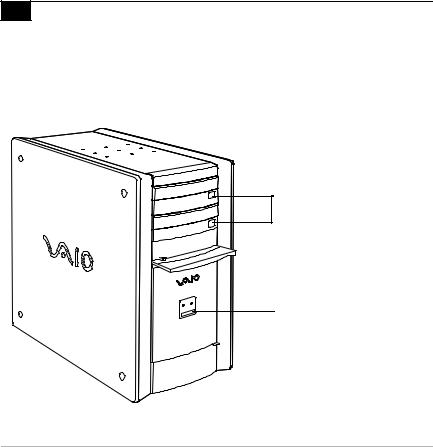
6 VAIO Digital Studio™ System Reference Manual
Buttons and Switches
All Models
Optical disc eject
 Floppy disk eject
Floppy disk eject
Power/Stand by
Button or switch |
Description |
Power/Stand by switch |
Turns system power on, off, or into Stand by |
|
mode. |
|
|
Floppy disk eject button |
Ejects a floppy disk. |
|
|
Optical disc eject button |
Automatically opens and closes the optical drive |
|
tray. |
|
|
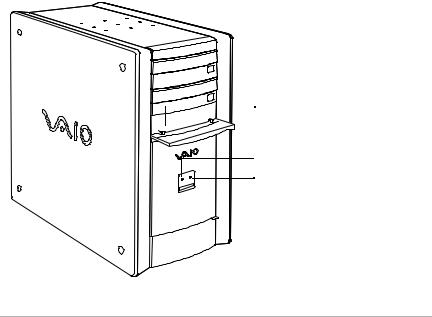
Identifying Components |
7 |
|
Indicators
All Models
 Floppy disk drive access
Floppy disk drive access
Hard disk drive access
Optical disc drive access
 Power/Stand by
Power/Stand by
Indicator |
Description |
Power/Stand by indicator |
Stand by (red) indicates the computer is in |
|
Stand by mode. |
|
On (blue) indicates the computer is out of |
|
Stand by mode, ready to use. |
|
Off (no color) indicates the computer is |
|
turned off, or in hibernation mode. |
|
|
Floppy disk drive access |
On (green) indicates floppy disk drive |
indicator |
activity. |
|
|
Optical drive access indicator |
On (red) indicates optical drive activity. |
|
|
Hard disk drive access indicator |
On (red) indicates hard disk drive activity. |
|
|
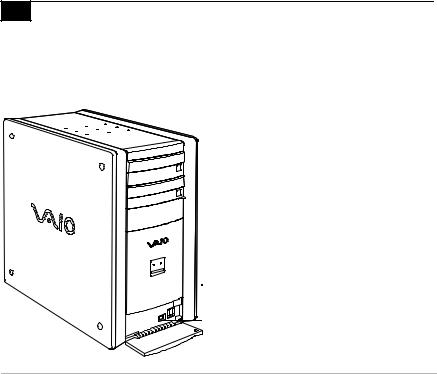
8 VAIO Digital Studio™ System Reference Manual
Connectors
PCV-RX462DS/PCV-RX463DS/PCV-RX465DS/PCV-RX470DS/PCV-RX480DS

 USB3, USB4
USB3, USB4
i.LINK
Connector |
Description |
i.LINK® (IEEE1394)* |
Connects to a digital device that has a 4-pin i.LINK |
|
header. |
|
|
USB3, USB4 |
Connects to USB devices. |
|
|
*To connect to a 6-pin i.LINK device, use the i.LINK header on the back of the system. A 6-pin i.LINK header can supply power from the computer to the device if the device also has a 6-pin i.LINK header. A 4-pin i.LINK header cannot supply power to the device.

Identifying Components |
9 |
|
PCV-RX490TV
|
USB |
|
i.LINK |
|
Video/Audio Inputs |
Connector |
Description |
Universal Serial Bus |
Connects to USB devices. |
(USB) ports (2) |
|
i.LINK (4-pin) port |
Connects to a digital device that has a 4-pin i.LINK |
(IEEE1394) |
connector. |
S-Video In port |
Connects to an S-video cable (optional). |
Video In jack |
Connects to a video cable (supplied). |
Audio L In jack/ |
Connects to an audio cable (supplied). |
Audio R In jack |
|
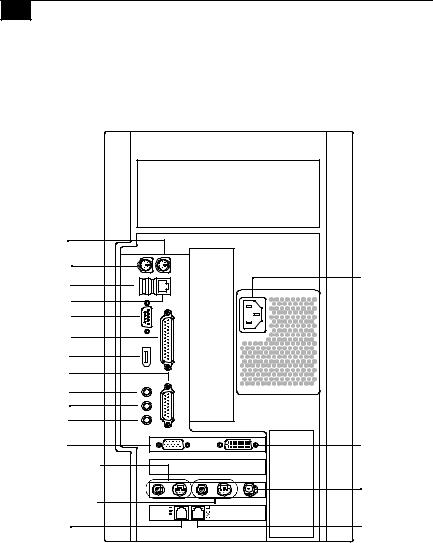
10 VAIO Digital Studio™ System Reference Manual
Rear View
All Models
Mouse |
|
Keyboard |
|
USB1, USB2 |
Power |
|
|
Ethernet |
|
Serial |
|
Printer |
|
/Parallel |
|
i.LINK |
|
(IEEE394) |
|
Game/MIDI |
|
Headphones |
|
Line In |
|
Microphone |
|
Monitor |
DVI |
|
|
Audio Out |
|
Video/S-video Out* |
|
Audio In |
VHF/UHF* |
|
|
Video/S-Video In* |
|
Line |
Telephone** |
*Only in PCV-RX490TV Model
**In models with an HPNA modem, the telephone line jack does not exist.
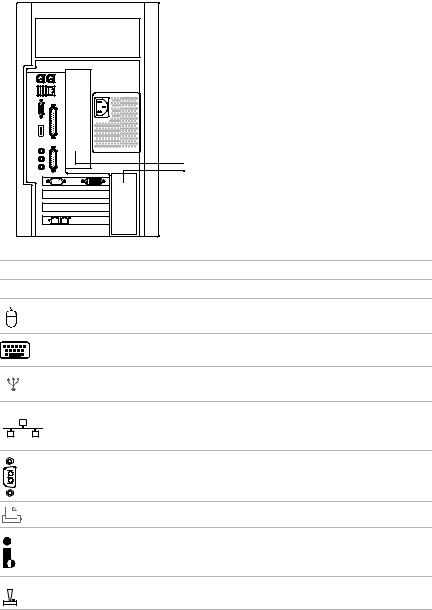
Identifying Components |
11 |
|
Icons
All Models
|
Icon Label Area |
All Models |
|
Icon |
Description |
Mouse port
Keyboard port
Universal Serial Bus (USB) port
Ethernet port (for LAN connection only)
Serial port
Printer port
i.LINK (IEEE1394) port
Game/MIDI port
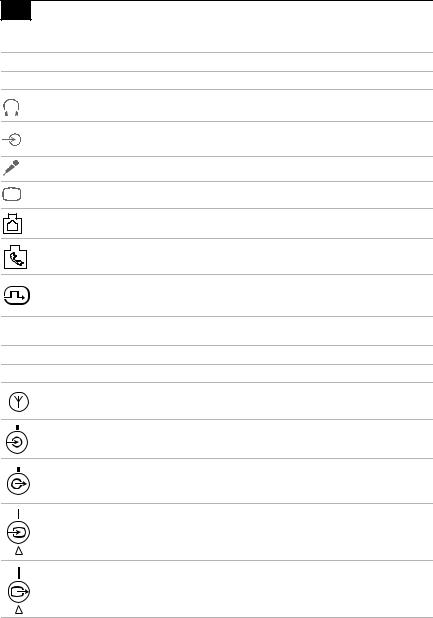
12 VAIO Digital Studio™ System Reference Manual
All Models
Icon Description
Headphones
LINE IN jack (audio)
Microphone jack
Monitor port
Line jack (for telephone line from primary service jack)
Telephone jack (for phone)*
DVI (LCD) Monitor port
* In models with an HPNA modem, the telephone jack does not exist.
PCV-RX490TV Only
Icon Description
VHF/UHF port
Audio In jack
Audio Out jack
Video/S-video In port
Video/S-video Out port

Identifying Components |
13 |
|
I/O Connectors
The following section identifies the various I/O connectors.
Keyboard and Mouse Ports
The keyboard and mouse ports are physically identical and have the same pinout. They are standard 6-pin PS/2®-type female ports.
2
3 1
4 |
6 |
|
5
USB Ports
The USB ports are standard 4-pin USB ports. Two USB ports are located at the front, and two at the rear of the system.
Ethernet Port
The Ethernet port at the rear of the system is used to connect to a 10Base-T/100Base-TX Ethernet network.
Ethernet

14 VAIO Digital Studio™ System Reference Manual
Serial Port
The serial port is a standard 9-pin DB-9 male port.
1
6
9
5
Printer/Parallel Port
The printer/parallel port is a standard 25-pin DB-25 female port.
13
25
14
1
Monitor Port
The monitor port is a standard 15-pin female high-density VGA-type port located on the AGP plug-in card.
10 |
|
15 |
5 |
11 |
1 |
6
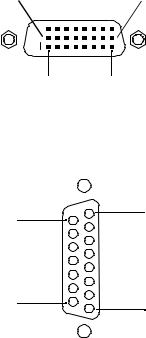
Identifying Components |
15 |
|
DVI Port
The DVI port is a 24-pin DVI port that can be attached to a Sony XGA LCD panel (PCVA-15XD2), which uses a DVI connector cable (sold separately). The DVI port is located on the AGP plug-in card.
You can physically connect both a VGA and an LCD monitor at the same time. However, you cannot use both monitors at the same time. If you operate only one monitor to the system, the system automatically detects which monitor is connected. If you connect both monitors, you must choose one monitor from the Display settings.
24 |
17 |
|
|
|||||||
16 |
|
|
|
|
|
|
DVI |
|
|
9 |
|
|
|
|
|
||||||
|
|
|
|
|
|
|
|
|
|
|
|
|
|
|
|
|
|
|
|
|
|
|
|
|
|
|
|
|
|
|
|
|
|
|
|
|
|
|
|
|
|
|
|
|
|
|
|
|
|
|
|
|
|
|
8 1
Game Port
The game port is a standard 15-pin DB-15 female port. This port can be used to connect MIDI devices.
8
15
9
1

16 VAIO Digital Studio™ System Reference Manual
Mic, Line In, and Headphones Jacks
The mic, line in, and headphones jacks are physically identical, but have different connections. They are standard 3.5 mm stereo mini-jacks.
Headphones |
Line In |
Mic |
Connector |
Description |
|
Headphones |
1.0 |
Vrms (typical). |
|
|
|
Mic |
Electret condenser microphone input. |
|
|
|
|
Line In |
1.0 |
Vrms (typical), 10 Kohm impedance. |
|
|
|
Telephone and Line Jacks
The telephone and line jacks are physically identical and have identical connections. they are standard rj-11 female phone jacks. however, the line jack is for connecting to a telephone line that comes from the wall, and the telephone jack is for connecting the computer to a telephone.
Your computer will only have one RJ-11 female phone jack if you have a HomePNA modem installed. The modem installed on your computer may differ depending on the configuration you purchased.
Line Phone
Accidentally plugging a phone line from the wall into the modem’s telephone jack, and a telephone into the line jack, will not damage the modem card or telephone equipment. However, the modem will not work correctly.
